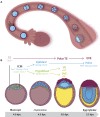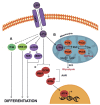Modeling Mammalian Commitment to the Neural Lineage Using Embryos and Embryonic Stem Cells
- PMID: 31354503
- PMCID: PMC6637848
- DOI: 10.3389/fphys.2019.00705
Modeling Mammalian Commitment to the Neural Lineage Using Embryos and Embryonic Stem Cells
Abstract
Early mammalian embryogenesis relies on a large range of cellular and molecular mechanisms to guide cell fate. In this highly complex interacting system, molecular circuitry tightly controls emergent properties, including cell differentiation, proliferation, morphology, migration, and communication. These molecular circuits include those responsible for the control of gene and protein expression, as well as metabolism and epigenetics. Due to the complexity of this circuitry and the relative inaccessibility of the mammalian embryo in utero, mammalian neural commitment remains one of the most challenging and poorly understood areas of developmental biology. In order to generate the nervous system, the embryo first produces two pluripotent populations, the inner cell mass and then the primitive ectoderm. The latter is the cellular substrate for gastrulation from which the three multipotent germ layers form. The germ layer definitive ectoderm, in turn, is the substrate for multipotent neurectoderm (neural plate and neural tube) formation, representing the first morphological signs of nervous system development. Subsequent patterning of the neural tube is then responsible for the formation of most of the central and peripheral nervous systems. While a large number of studies have assessed how a competent neurectoderm produces mature neural cells, less is known about the molecular signatures of definitive ectoderm and neurectoderm and the key molecular mechanisms driving their formation. Using pluripotent stem cells as a model, we will discuss the current understanding of how the pluripotent inner cell mass transitions to pluripotent primitive ectoderm and sequentially to the multipotent definitive ectoderm and neurectoderm. We will focus on the integration of cell signaling, gene activation, and epigenetic control that govern these developmental steps, and provide insight into the novel growth factor-like role that specific amino acids, such as L-proline, play in this process.
Keywords: L-proline; amino acids; definitive ectoderm; early primitive ectoderm-like cells; embryonic stem cell; neural; neurectoderm; primitive ectoderm.
Figures









Similar articles
-
Transient pluripotent cell populations during primitive ectoderm formation: correlation of in vivo and in vitro pluripotent cell development.J Cell Sci. 2002 Jan 15;115(Pt 2):329-39. doi: 10.1242/jcs.115.2.329. J Cell Sci. 2002. PMID: 11839785
-
Directed differentiation of pluripotent cells to neural lineages: homogeneous formation and differentiation of a neurectoderm population.Development. 2002 Jun;129(11):2649-61. doi: 10.1242/dev.129.11.2649. Development. 2002. PMID: 12015293
-
The appearance and extension of neural differentiation tendencies in the neurectoderm of the early chick embryo.Wilhelm Roux Arch Entwickl Mech Org. 1968 Jun;160(2):187-236. doi: 10.1007/BF00572650. Wilhelm Roux Arch Entwickl Mech Org. 1968. PMID: 28304523
-
Developmental complexity of early mammalian pluripotent cell populations in vivo and in vitro.Reprod Fertil Dev. 1998;10(7-8):535-49. doi: 10.1071/rd98084. Reprod Fertil Dev. 1998. PMID: 10612459 Review.
-
Towards a cellular and molecular understanding of neurulation.Dev Dyn. 2001 Jun;221(2):117-45. doi: 10.1002/dvdy.1144. Dev Dyn. 2001. PMID: 11376482 Review.
Cited by
-
In Vitro Fertilisation of Mouse Oocytes in L-Proline and L-Pipecolic Acid Improves Subsequent Development.Cells. 2021 May 29;10(6):1352. doi: 10.3390/cells10061352. Cells. 2021. PMID: 34072568 Free PMC article.
-
Cell fate decisions, transcription factors and signaling during early retinal development.Prog Retin Eye Res. 2022 Nov;91:101093. doi: 10.1016/j.preteyeres.2022.101093. Epub 2022 Jul 8. Prog Retin Eye Res. 2022. PMID: 35817658 Free PMC article. Review.
-
Identification of Estrogen-Responsive Proteins in Mouse Seminal Vesicles Through Mass Spectrometry-Based Proteomics.Pharmaceuticals (Basel). 2024 Nov 9;17(11):1508. doi: 10.3390/ph17111508. Pharmaceuticals (Basel). 2024. PMID: 39598420 Free PMC article.
-
A ubiquitin-based effector-to-inhibitor switch coordinates early brain, craniofacial, and skin development.Nat Commun. 2023 Jul 26;14(1):4499. doi: 10.1038/s41467-023-40223-y. Nat Commun. 2023. PMID: 37495603 Free PMC article.
-
Maintenance of pluripotency in the entire ectoderm enables neural crest formation.Res Sq [Preprint]. 2023 Jan 25:rs.3.rs-2285117. doi: 10.21203/rs.3.rs-2285117/v1. Res Sq. 2023. Update in: Nat Commun. 2023 Sep 23;14(1):5941. doi: 10.1038/s41467-023-41384-6. PMID: 36747797 Free PMC article. Updated. Preprint.
References
-
- Aguilar J., Reyley M. (2005). The uterine tubal fluid: secretion, composition and biological effects. Anim. Reprod. 2, 91–105. Available at: http://www.cbra.org.br/pages/publicacoes/animalreproduction/issues/downl... [Accessed September 10, 2015]
Publication types
LinkOut - more resources
Full Text Sources

